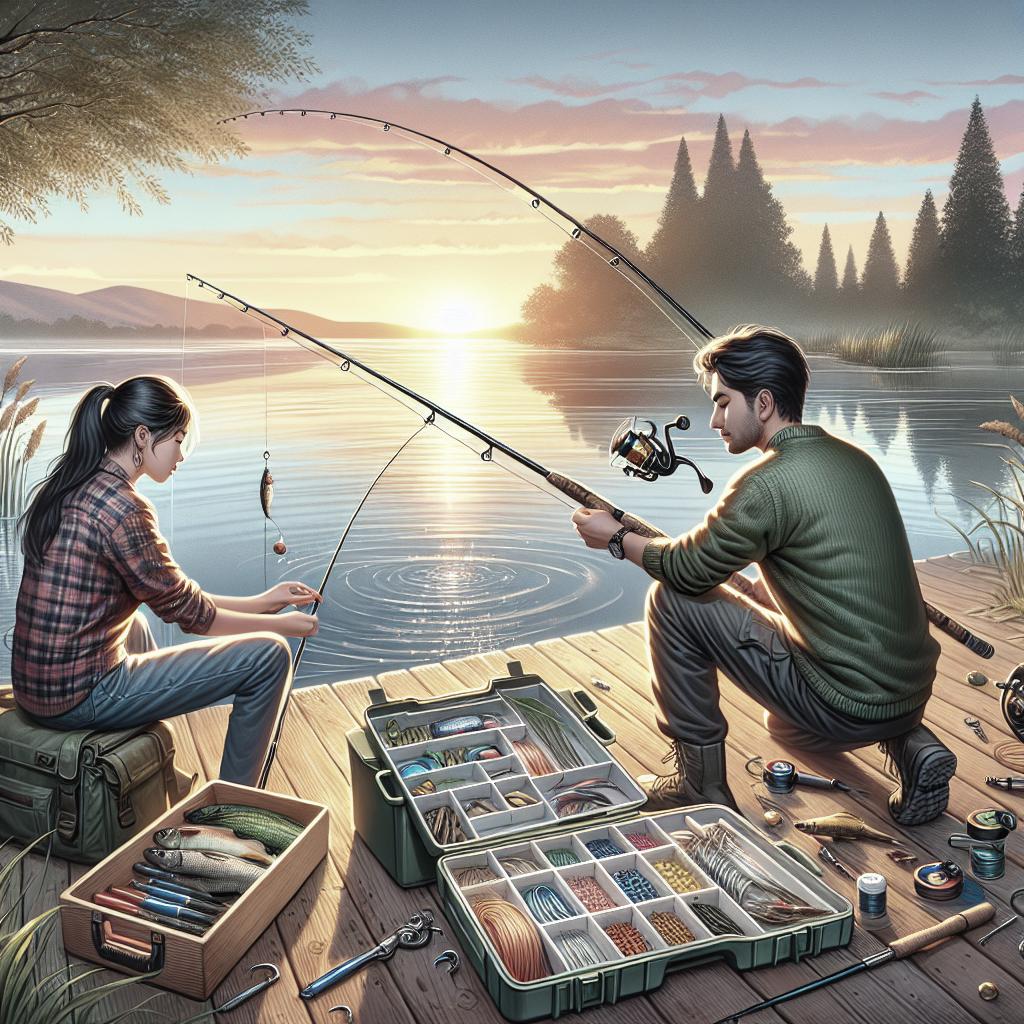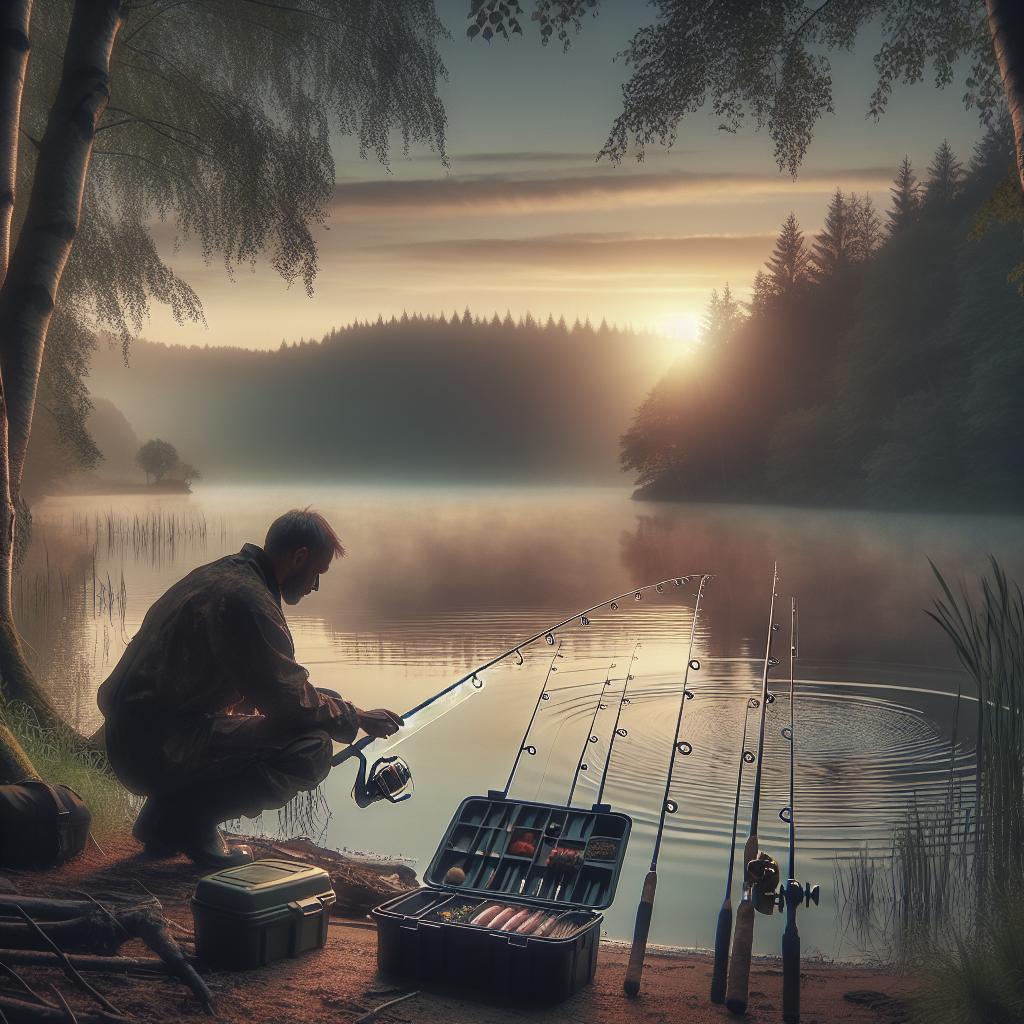Fishing, a time-honored pastime, has provided sustenance and leisure for generations. For beginners, understanding the essentials can significantly enhance the experience, transforming frustration into satisfaction. In this post, we’ll explore ten vital tips every novice angler should know. From selecting the perfect lures to understanding the best times to fish, this guide is crafted to provide foundational knowledge and practical advice. ### 10 Tips on How to Fish for Beginners ### 1. Fishing Lure Colors Choosing the right lure color is crucial for attracting fish. Colors that mimic a fish’s natural prey tend to be the most effective. For instance, in clear waters, natural colors like greens, silvers, and browns are ideal as they blend well with the environment. In contrast, more vibrant colors such as chartreuse or bright orange are better for murky conditions, as they draw attention. Understanding seasonal color changes can also be beneficial. During spring and fall, when fish are more active, bolder colors might entice fish better. In summer, when fish tend to be sluggish, subtler hues might be more effective. The key is to experiment and adjust based on the circumstances to see what works best. ### 2. Fishing Lure Shapes & Sizes Just as color matters, so do the shape and size of a fishing lure. Different species of fish are attracted to different shapes and sizes. Larger fish tend to respond better to bigger lures, which represent larger prey, while smaller lures are ideal for smaller fish. Lure shape affects motion, which can influence a fish’s decision to strike. For example, long slender lures can mimic the swimming patterns of baitfish, while rounder lures may waddle side-to-side, imitating a distressed prey. Beginners should start with versatile lures, like crankbaits, that cover various conditions effectively. ### 3. The Right Size Fishing Gear The importance of choosing appropriately sized fishing gear cannot be overstated. Gear should match the fishing environment and the target species. For example, heavy rods are typically used for saltwater fishing or when targeting larger fish, while lighter rods are suitable for freshwater fishing and smaller species. Understanding rod action is another critical factor. Fast action rods bend near the tip, offering greater sensitivity, while slow-action rods provide a broader bend, ideal for smaller species. As a beginner, investing in medium gear provides a balanced start for most fishing scenarios. ### 4. Trolling Trolling involves dragging a lure or bait behind a moving boat and is an effective technique for covering large water areas. It allows beginners to encounter various fish species, helping improve technique quickly. Success in trolling requires understanding how speed and lure depth affect your chances. Varying the trolling speed can influence fish strikes; slower speeds work better in colder waters, while faster speeds are more effective in warmer ones. Pay attention to your rod tip, as subtle movements can indicate a bite. Adjusting lure depth also increases the chances of reaching the right fish. ### 5. Fishing Line Choosing the right fishing line is crucial for any fishing adventure. There are generally three types to choose from: monofilament, fluorocarbon, and braided lines. Beginners should consider monofilament, as it’s versatile, forgiving, and easy to handle. The line’s thickness affects its visibility in water, with thicker lines being more visible but stronger, while thinner lines offer stealth but less strength. Practice tying knots and casting to ensure the line is properly set up and ready to use, enhancing your overall fishing proficiency. ### 6. Best Time of the Day for Fishing Timing can significantly influence a fishing outing’s success. Dawn and dusk are traditionally considered the best times as fish are more active during these transition periods. During these hours, fish come closer to the surface to feed, increasing the chances of catching them. However, the best times might vary depending on the fishing location and species targeted. Research and experience will guide a beginner in determining the best times specific to their preferred fishing spots, making every trip more rewarding and fruitful. ### 7. Tides & Currents Understanding tides and currents can greatly impact fishing success, especially in saltwater environments. Generally, fish are more active during the change in tides, as these movements stir up the water and carry food sources. Beginners should learn to read tide charts and understand how current flow influences fish behavior. Fishing just after high or low tide often yields the best results. This understanding enables anglers to plan their fishing trips strategically, increasing their chances of success. ### 8. Sharp Hooks A sharp hook is vital for ensuring that once a fish bites, it’s securely caught. Hooks can dull over time, particularly after numerous uses or repeated striking on rocks or debris. Regularly checking and sharpening hooks can make all the difference. Using a hook sharpener, anglers can maintain the pointed end, ensuring it penetrates easily. It’s also good practice to have a variety of hook sizes available, depending on the target fish, as their mouth sizes vary widely. ### 9. Reel Drag The drag system on a reel plays a crucial role in successfully landing fish. It provides the right amount of resistance, allowing the line to extend during a fight without snapping. Beginners need to understand how to adjust drag settings for different fishing scenarios. To set the reel drag, test it with the fishing line and adjust until the resistance feels firm but not too tight. Practicing drag settings helps handle unexpected catches effectively, ensuring that when the big one bites, the setup will hold strong. ### 10. Do Your Research As with any skill, research and learning are integral to becoming proficient at fishing. Beginners should take advantage of online resources, tutorials, and local fishing communities to expand their knowledge and skills. Joining forums and engaging with fellow anglers can provide invaluable insights. Trial and error, along with well-conducted research, will increase an angler’s confidence and understanding of various fishing techniques. Over time, this accumulated knowledge allows for personalized tactics that align with individual fishing styles and preferences. ### Future Prospects To succeed in fishing, beginners need a strong foundation in the basics. Equipped with these tips, new anglers can confidently embark on their journeys, gradually honing their skills and adapting techniques. Remember that fishing is as much about the experience and relaxation as it is about success. Here’s a concise look at the tips discussed in this post: “`html
| Tip | Key Points |
|---|---|
| 1. Fishing Lure Colors | Choose colors based on water clarity; experiment with natural and bold colors seasonally. |
| 2. Fishing Lure Shapes & Sizes | Select shapes and sizes based on target species; use versatile lures for varied conditions. |
| 3. The Right Size Fishing Gear | Match gear size to fishing environment and species; start with medium gear. |
| 4. Trolling | Drag lures behind a moving boat; adjust speed and depth for effectiveness. |
| 5. Fishing Line | Choose between monofilament, fluorocarbon, and braided; practice tying knots. |
| 6. Best Time of the Day for Fishing | Fish during dawn and dusk; adjust according to location and species. |
| 7. Tides & Currents | Consider tides and currents in saltwater; fish during changing tides. |
| 8. Sharp Hooks | Ensure hooks are sharp; regularly check and maintain them. |
| 9. Reel Drag | Understand and set reel drag properly for different scenarios. |
| 10. Do Your Research | Utilize online resources, join communities, and learn continuously. |
“` Embrace the thrill of fishing with patience and persistence, knowing that each outing is an opportunity to learn and improve!


